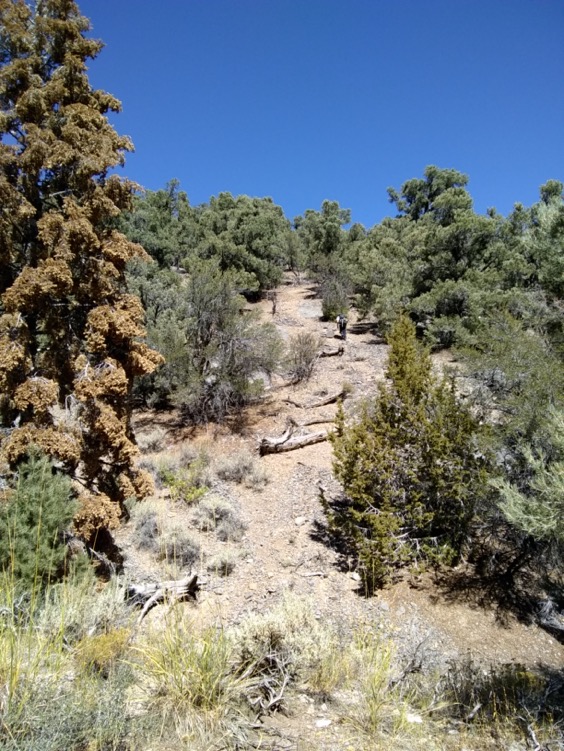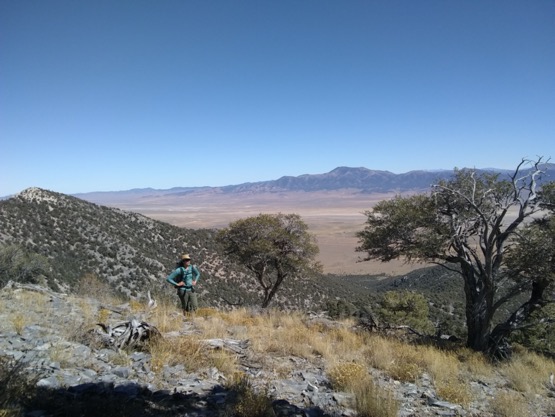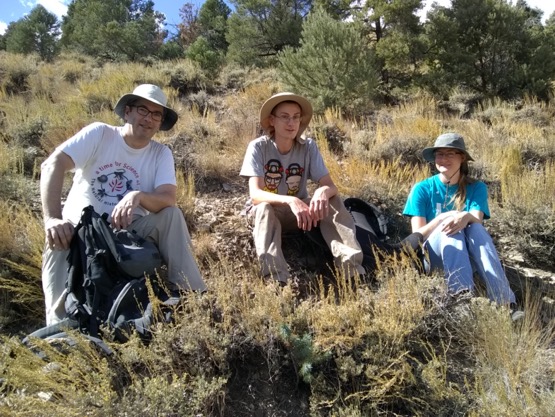In September the lab group got away for our becoming-customary week of autumn fieldwork in the Great Basin. This involves two days driving, five days of fieldwork, and two days of driving home. This year we scraped up enough money to rent a university Suburban and were able to bring all of our rock samples home in it. We first drove to Delta, Utah, with a stopover night in Fort Morgan, Colorado. We met Talia, who drove in from Boulder, in Delta. Over the course of two days we made huge new collections from the upper Stairsian horizon Section G 48.5 m and the mid-Stairsian buildup fauna at Section MME 49.8 m. Thrombolites just aren't fun to collect, but we managed to find one head with decent silicified trilobites showing in the matrix and excavated it and somehow got it to pop out. Breaking it up was still seriously painful. It ended up filling 11 sacks. We also visited Section J. This is one of the most-visited Early Paleozoic sections in the western US - tons and tons of field camps and meeting field trips go there. Access is now more or less blocked off. The region to the west of the road is a designated federal wilderness study area and is supposed to be vehicle-free. The BLM seems to finally be doing something about this. They've put up a metal barrier blocking access to the small lane that runs along the base of Section G. At J there's no barrier, but they blocked off the road with a bunch of large boulders. They aren't too big to move with some effort and I'm sure somebody will. I chose to respect their wishes, but I'm sure glad I'm finished with the bulk silicified sampling at Section J. So we walked in (it's a reasonable distance, but probably less than a mile). The main thing I wanted to do was take another close look at the Kanosh, in search of limestone lumps with a new genus of bathyurids. We found a few, but not as many as on the NAPC field trip the past June. We also stopped and looked at the Kanosh at Camp Section, but didn't find much.

Rebecca on her way up the basal slope of the "Hill of Death" at Barton Canyon in the Cherry Creek Range.
After that we relocated to Ely and checked into the Hotel Nevada. I hadn't stayed there prior to the NAPC trip and kind of assumed it was dodgy, but the rooms are really quite nice and I like hanging around in the bar area of the casino after a day of fieldwork. The main thing I wanted to do here was go up the Cherry Creeks and try to really scout the silicified Skullrockian faunas in the "Goodwin Formation" near the top. As it turned out, that didn't happen. The first day we just weren't making adequate time (I wrote about the grueling climb years ago in American Paleontologist). We stopped when we found decent looking silicified faunas in the Sunwaptan at levels that hadn't been collected before. We carried down a decent amount. The second day my knees gave out (the first time that's ever happened - age, it'll kill ya) and I had to hobble down. Talia and the two students went on up and stayed until after dark.

Talia standing near the contact between the Barton Canyon Limestone and the Catlin Member of the Bullwhacker Formation.
On the final day, we went to Cleve Creek to see what the prospects were for making more collections from the Marjuman-Sunwaptan section Steve Westrop and I measured and collected years ago. To start with, I couldn't find the section and we spent hours walking all over the place. Alex finally found it, uncovering some of our old meterage numbers. It turned out that the slope had experienced some major mass movement events over the years, certainly a result of thunderstorms. Only segments of the section could be located. Several painted markers were found washed all the way to the bottom of the hill. I got my bearings and found some of the horizons, but for the most part the outcrop had been covered. It wasn't very well exposed to begin with. We got some really beautiful collections from that section, but they were rare. Most of the limestone has high quartz content and doesn't break down in acid.

The lab group (L-R, me, Alex, and Rebecca) at the Cleve Creek locality in eastern Nevada.